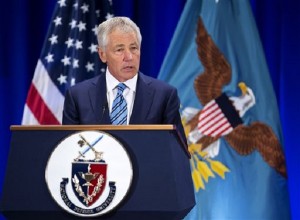
Defense Secretary Chuck Hagel speaks at the National Defense University at Fort McNair in Washington, Wednesday, April 3, 2013. Hagel labeled North Korea’s rhetoric as a real, clear danger and threat to the U.S. and its Asia-Pacific allies. He said the U.S. is doing all it can to defuse the situation, echoing comments a day earlier by Secretary of State John Kerry. AP/Manuel Balce Ceneta
WASHINGTON — The Defense Department said it was deploying a missile defense shield to the territory of Guam in the Pacific to protect the U.S. and its allies in the region in response to North Korea’s increasingly hostile talk. The North renewed its threat to launch a nuclear attack on the United States.
The threat issued by the General Staff of the Korean People’s Army capped a week of psychological warfare and military moves by both sides that have rattled the region.
On Wednesday, the Pentagon announced it will deploy a high-altitude missile defense system to Guam to strengthen the Asia-Pacific region’s protections against a possible attack.
Pyongyang, for its part, said America’s ever-escalating hostile policy toward North Korea “will be smashed” by the North’s nuclear strike and the “merciless operation” of its armed forces.
“The U.S. had better ponder over the prevailing grave situation,” said the translated statement, which was issued before the Pentagon announced plans to send a missile defense shield to Guam.
The Pentagon had no immediate reaction to the latest statement, but earlier Wednesday Defense Secretary Chuck Hagel labeled North Korea’s rhetoric as a real, clear danger and threat to the U.S. and its Asia-Pacific allies. And he said the U.S. is doing all it can to defuse the situation, echoing comments a day earlier by Secretary of State John Kerry.
“Some of the actions they’ve taken over the last few weeks present a real and clear danger and threat to the interests, certainly of our allies, starting with South Korea and Japan and also the threats that the North Koreans have leveled directly at the United States regarding our base in Guam, threatened Hawaii, threatened the West Coast of the United States,” said Hagel.
He said he believes that the U.S. has had a “measured, responsible, serious responses to those threats.”
Deployment of the Terminal High Altitude Area Defense System is the latest step the U.S. has taken to bolster forces in the region in a far-reaching show of force aimed at countering the North Korean threat.
The Pentagon already has sent dispatched bombers, stealth fighters and ships.
Tensions have escalated between North and South Korea in recent weeks. The communist North has vowed to increase production of nuclear weapons materials, and threatened a pre-emptive strike against the U.S.
Hagel told an audience at the National Defense University that there is a path to peace on the troubled Korean peninsula, but it doesn’t include making nuclear threats or taking provocative actions.
The land-based missile defense system includes a truck-mounted launcher, tracking radar, interceptor missiles, and an integrated fire control system. The Pentagon said the system will boost defenses for American citizens in Guam, a U.S. territory, and U.S. forces stationed there.